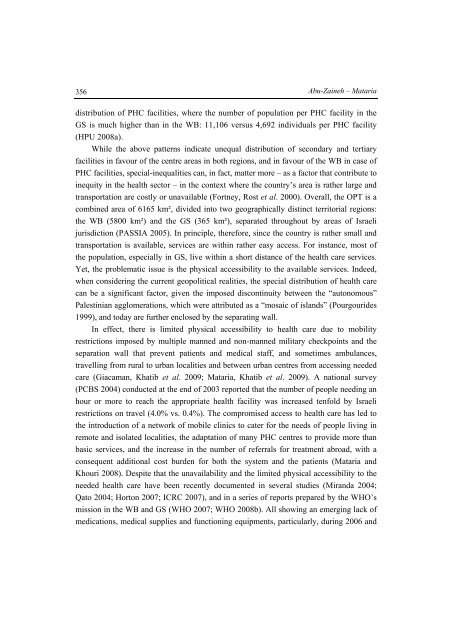The Palestinian Economy. Theoretical and Practical Challenges
The Palestinian Economy. Theoretical and Practical Challenges
The Palestinian Economy. Theoretical and Practical Challenges
Create successful ePaper yourself
Turn your PDF publications into a flip-book with our unique Google optimized e-Paper software.
356<br />
Abu-Zaineh – Mataria<br />
distribution of PHC facilities, where the number of population per PHC facility in the<br />
GS is much higher than in the WB: 11,106 versus 4,692 individuals per PHC facility<br />
(HPU 2008a).<br />
While the above patterns indicate unequal distribution of secondary <strong>and</strong> tertiary<br />
facilities in favour of the centre areas in both regions, <strong>and</strong> in favour of the WB in case of<br />
PHC facilities, special-inequalities can, in fact, matter more – as a factor that contribute to<br />
inequity in the health sector – in the context where the country’s area is rather large <strong>and</strong><br />
transportation are costly or unavailable (Fortney, Rost et al. 2000). Overall, the OPT is a<br />
combined area of 6165 km², divided into two geographically distinct territorial regions:<br />
the WB (5800 km²) <strong>and</strong> the GS (365 km²), separated throughout by areas of Israeli<br />
jurisdiction (PASSIA 2005). In principle, therefore, since the country is rather small <strong>and</strong><br />
transportation is available, services are within rather easy access. For instance, most of<br />
the population, especially in GS, live within a short distance of the health care services.<br />
Yet, the problematic issue is the physical accessibility to the available services. Indeed,<br />
when considering the current geopolitical realities, the special distribution of health care<br />
can be a significant factor, given the imposed discontinuity between the “autonomous”<br />
<strong>Palestinian</strong> agglomerations, which were attributed as a “mosaic of isl<strong>and</strong>s” (Pourgourides<br />
1999), <strong>and</strong> today are further enclosed by the separating wall.<br />
In effect, there is limited physical accessibility to health care due to mobility<br />
restrictions imposed by multiple manned <strong>and</strong> non-manned military checkpoints <strong>and</strong> the<br />
separation wall that prevent patients <strong>and</strong> medical staff, <strong>and</strong> sometimes ambulances,<br />
travelling from rural to urban localities <strong>and</strong> between urban centres from accessing needed<br />
care (Giacaman, Khatib et al. 2009; Mataria, Khatib et al. 2009). A national survey<br />
(PCBS 2004) conducted at the end of 2003 reported that the number of people needing an<br />
hour or more to reach the appropriate health facility was increased tenfold by Israeli<br />
restrictions on travel (4.0% vs. 0.4%). <strong>The</strong> compromised access to health care has led to<br />
the introduction of a network of mobile clinics to cater for the needs of people living in<br />
remote <strong>and</strong> isolated localities, the adaptation of many PHC centres to provide more than<br />
basic services, <strong>and</strong> the increase in the number of referrals for treatment abroad, with a<br />
consequent additional cost burden for both the system <strong>and</strong> the patients (Mataria <strong>and</strong><br />
Khouri 2008). Despite that the unavailability <strong>and</strong> the limited physical accessibility to the<br />
needed health care have been recently documented in several studies (Mir<strong>and</strong>a 2004;<br />
Qato 2004; Horton 2007; ICRC 2007), <strong>and</strong> in a series of reports prepared by the WHO’s<br />
mission in the WB <strong>and</strong> GS (WHO 2007; WHO 2008b). All showing an emerging lack of<br />
medications, medical supplies <strong>and</strong> functioning equipments, particularly, during 2006 <strong>and</strong>
















